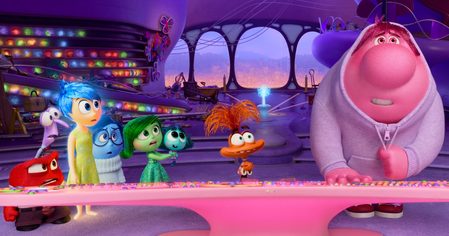MANILA, Philippines – Even at a young age, kids are already learning how to communicate with others and recognize emotions — from their own facial expressions to those of the people they’re talking to, whether fellow children or adults.
As they grow and engage with their environment, it helps to start early conversations about emotions and mental health. Sometimes, it can be as simple as introducing them to animated films and storybooks that talk about feelings and emotions.
Through stories told from a child’s perspective, they can see that it’s okay to feel excited, sad, anxious, or angry. This list of books, films, and series teaches the youth that it’s totally normal to feel different emotions, and that acknowledging these feelings is a step toward better mental health and empathy for others.
‘Emotions’ Picture Book series
Adarna House’s Emotions Picture Book series brings a Filipino touch to emotional learning. Each title helps readers name and identify emotions like hiya (shyness), inip (boredom), sabik (excitement), kilig, gigil (cute aggression), sungit (grumpy), and pikon (short-tempered). These books easily capture a kid’s attention since, even before opening the pages, emotions are already illustrated on their expressive covers.
Written and illustrated by local talents such as Beth Parrocha (Sabik), Jamie Bauza (Gigil), and Pergy Acuña (Kilig), each story allows children to explore not just the feeling itself but also how to respond to it. Through this collection, simply knowing what an emotion looks like is one easy way to understand it.
‘Damdaman: Feelings in Filipino’
Written by Jocelyn Francisco and illustrated by Clarissa Tong, Damdaman: Feelings in Filipino is a creative way to connect emotions with nature. The title combines the Filipino terms damdam (feelings) and halaman (plants), creating a garden of emotions — from sadness and happiness to hunger and sleepiness.
Inspired by the makahiya, a plant that gets shy when touched, this book sends a message to children that they are free to react whenever they feel overwhelmed. Damdaman also serves as a reminder that even nature feels, just like we humans do.
‘Ang mga Alon sa Amin’
A bilingual children’s book written in Filipino and English, Ang Mga Alon sa Amin offers comfort to youth who have experienced fear or loss. Written by Rainey Dolarte, it tells a story of courage, healing, and growth through Mario, a Tagbanua boy from Palawan whose community was heavily affected by Super Typhoon Yolanda (Haiyan) in 2013.
Apart from its storyline, the book also features expressive art activities that allow parents to encourage their kids to talk about their emotions and learn healthy ways to cope with stress.
‘Federico’
Written by Palanca hall of famer Eugene Evasco, the classic storybook Federico features the story of a child with Down syndrome, seen through the eyes of his friend Buboy. Its touching narrative serves as a reminder to young readers that mental health and emotional understanding begin with empathy.
Through Federico’s story, it can be understood that every child feels, thinks, and expresses themselves differently — and that strength can come from sensitivity and kindness.
‘Inside Out’ (2015) and ‘Inside Out 2’ (2024)
Pixar’s Inside Out film remains a valuable film for teaching kids about emotions. Through the story of an 11-year-old girl named Riley, emotions named Joy, Sadness, Anger, Fear, and Disgust are introduced. The film guides young viewers to understand the purpose of every emotion.
Nearly a decade later, its sequel Inside Out 2 introduced new characters: Anxiety, Ennui, Embarrassment, and Envy, along with Nostalgia’s brief cameos. These new feelings perfectly capture the adolescent phase of Riley, full of mixed and unfamiliar emotions for young people.
‘Encanto’ (2021)
Disney’s Encanto film tells the story of the magical Familia Madrigal, where every family member is gifted but not without hidden personal struggles.
Apart from its songs and colorful animation, Encanto‘s story makes it a must-watch as it explores generational trauma, people-pleasing, and the journey toward healing unspoken pain. For many children (and even adults), the film serves as a reminder that even the strongest families must learn to talk about their feelings, especially about what hurts them.
‘Turning Red’ (2022)
Turning Red follows the story of a 13-year-old who turns into a giant red panda whenever she experiences overflowing emotions.
Play Video

While Turning Red is light, heartwarming, and fun, the film captures the chaos of puberty, self-discovery, and the challenges of managing relationships. It also shows that change — even the messy kind — is a natural part of growing up.
‘Bluey’
The Emmy Kids Award-winning animated series Bluey has become a favorite among young fans not just because of its fun and adorable dog characters, Bluey and Bingo, but also for its genuine portrayal of childhood and parenthood.
With three successful seasons, each episode of Bluey addresses emotions such as anxiety or disappointment through relatable everyday situations.
‘Hilda’
Netflix’s Hilda is a melancholic series that deals with emotional maturity. As Hilda navigates her whimsical world, viewers are introduced to themes of loneliness, curiosity, and courage.
Play Video

This series unpacks the natural capacity of its young audiences to feel deeply and think critically about their emotions.
‘Baby Bots Backyard Tales’
From the educational cartoon channel Lingokids, Baby Bots Backyard Tales turns short episodes into life lessons. Each video helps children explore common feelings like loneliness, nervousness, and anger — even teaching them how to say “no.”
In just a few minutes per episode, young audiences learn emotional lessons in a fun and engaging way. – Rappler.com
Alessandria Corral is a Rappler intern studying Bachelor of Arts in Speech Communication at University of the Philippines Diliman.


